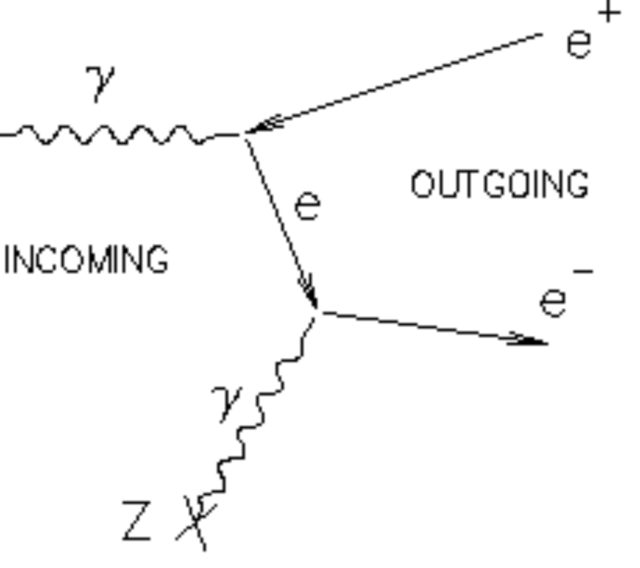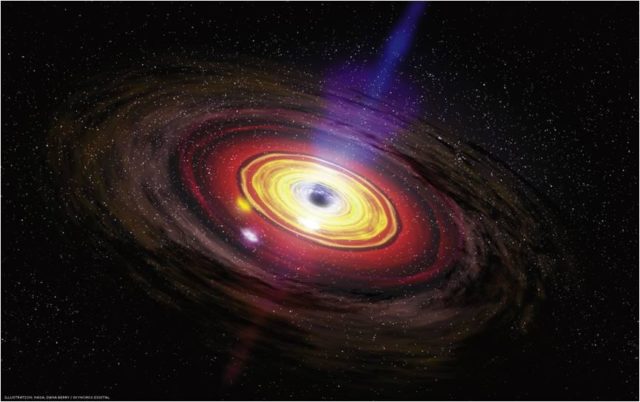Beyond an invisible horizon
Author: Marina Manganaro / The MAGIC Telescopes
The view of the horizon has always been of great inspiration for humans: that line, separating our Earth from the sky, appears so real. Looking at the Sea and its intersection with the sky, one can not avoid to wonder which things are still out of there to be found. A famous poem by Giacomo Leopardi 1 is dedicated to the perception of the infinite when looking at the horizon: and the feeling Leopardi describes is coming not just from contemplating the horizon itself, but from some obstacle to a complete view of that, an hedge which limits the field of view. Limits and obstacles stand in the way to discoveries, but they could also be the reason why we start the journey in search of something new for us.
Astrophysicists study the Universe trying to understand its fabric and the cosmological parameters describing it. The lights we see in the night sky are coming from enormous distances. The photons, massless particles which are the quanta exchanging the electromagnetic interaction (they are the light itself, we can say) can travel from distant galaxies and stars and finally reach the Earth. Photons produced by galactic and extragalactic sources can have different energies, depending on how they are produced, the distance they cover, and the interaction they can have during their journey. So different kind of telescopes have been built in order to detect all the possible ranges of photons reaching us from the Universe.
This means we can study the light from stars and galaxies in all the frequencies, not only in the ones which are visible to the human eye. Different energies mean different frequencies, as it is shown by the Planck-Einstein equation: E = hν. Where E is the energy of the photon, h the Planck’s constant and ν the frequency of the photon. Photons with very-high-energy have such high frequency that they are not visible by the human eye, and very special telescopes have to be built in order to see them. Such energetic high frequency photons have a special name: VHE (very-high-energy) gamma-rays. They are produced in the most violent processes which can occur in our Universe: they reach a tremendous energy of more than 100 Giga electron Volts (approximately 10 millions time the average kinetic energy of one human red blood cell) after being accelerated by the powerful engines in the centre of some galaxies: the so called Active Galactic Nuclei. The travel of such energetic gamma rays is not easy like the one of “normal” photons. VHE gamma rays are so energetic that can interact with other less energetic photons which are in the middle of their way and “hit” them, producing in such collision an electron-positron pair. This process, known as pair production is represented by the Feynman diagram in Figure 1.

VHE gamma rays will then produce electron-positron pairs while interacting with the less energetic photons which fills the space. Such radiation is called extragalactic background light (EBL) and VHE gamma rays are affected by their presence, while other lower energetic particles can travel trough the EBL without feeling its presence. Of course, the farther is the source of gamma rays, the most noticeable will be their interaction with the EBL before to reach Earth: and if the source is significantly distant, then no VHE gamma rays will be able to reach us and our telescopes. This means that the Universe is opaque to VHE gamma rays beyond a certain distance.
This is the cosmic horizon for photons astrophysicist have in mind: beyond that horizon active galactic nuclei could emit VHE gamma rays in many ways but we are not able to detect them. In astroparticle physics this limit is expressed by The Cosmic Gamma-ray Horizon 2. The precise expression for such an entity is shown in Eq. 2. For any given gamma-ray energy, the Cosmic Gamma-Ray Horizon is defined as the source redshift for which the optical depth is τ (E, z) = 1, where

and n(ε , z´) is the spectral density of the background photons at z´. The redshift of a source is a measure of its distance: calculations have shown that after approximately redshift z=1 it is impossible to detect VHE gamma rays for the current generation of telescopes.
This kind of telescopes are the so-called IACT (Imaging Atmosferic Cherenkov telescopes), and they are built in order to use the Earth atmosphere as a giant detector, which allows us to identify VHE gamma rays from the showers of particles they produce colliding with the atoms of the atmosphere. In such collisions the produced particles are crossing the atmosphere with a speed which is faster than the speed of the light would have in that medium: and in such a situation particles emit a faint blue light called Cherenkov light, which is the one detected by the IACTs. Telescopes using this technique are just a few on Earth: the H.E.S.S. array, the VERITAS array, and the MAGIC (Major Atmospheric Gamma-ray Imaging Cherenkov) twin telescopes.

Knowing well their limits in redshift and the cosmic horizon which separated them from the most distant Universe, astroparticle physicist working at those experiments were conscious of the impossibility in reaching high redshift such z=1. But then in 2015 the unexpected happened: the MAGIC telescopes detected not only one source close to z=1 redshift, but two of them. The farthest distance ever reached at that time was 0.6 redshift only. Now suddenly that limit was overcome and the telescopes were able to appreciate a signal from the middle age of the Universe. The two galaxies detected were PKS 1441 + 25 3 and QSO B0218 + 357 4, respectively at the redshift of z= 0.939 and z=0.944.
MAGIC researchers were extremely excited because they could be able to see a long way beyond their horizon and push their boundaries. Of course such discoveries were great opportunities to test the EBL with new measurements: the more distant you can go, the more information you can extract from the travel of the gamma-rays and consequently learn how the universe fabric is made along that path.
But how was possible to go beyond a such precise and theoretically well described horizon? The answer was in the energy threshold of the MAGIC telescopes: after an upgrade happened in 2011, and a lot of work on the improving of the telescopes performance, the twin telescopes were able to extend their low energy threshold for the detection of VHE gamma rays down to 25 GeV instead of the classical 100-200 GeV threshold valid for a generic IACT. Recent results on the characteristic of the EBL has been published by the MAGIC collaboration including for the first time the two most distant sources ever detected in the VHE gamma-ray band 5. New generation of IACTs will expand further the knowledge of our Universe in this extreme energy range.
References
- G. Leopardi. L’infinito. (1819) ↩
- O. Blanch and M. Martinez, Exploring the gamma ray horizon with the next generation of gamma ray telescopes. Part 1: Theoretical predictions, Astroparticle Physics, 23(6):588–597, (2005). ↩
- M. L. Ahnen et al. Very High Energy γ-Rays from the Universe’s Middle Age: Detection of the z = 0.940 Blazar PKS 1441+25 with MAGIC. ApJ, 815(2):L23, (2015). ↩
- M. L. Ahnen et al., Detection of very high energy gamma-ray emission from the gravitationally lensed blazar QSO B0218+357 with the MAGIC telescopes,A&A, 595:A98, (2016). ↩
- V. A. Acciari et al. , Measurement of the extragalactic background light using MAGIC and Fermi-LAT gamma-ray observations of blazars up to z =1, MNRAS, 486(3):4233–4251, (2019) ↩